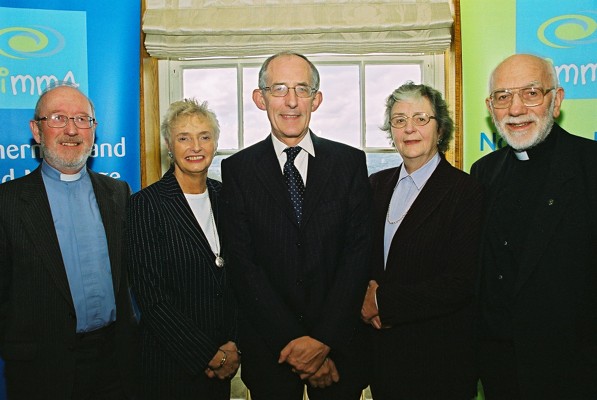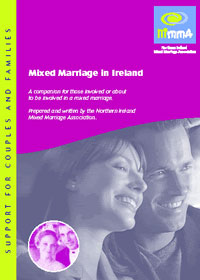"Supporting couples who are united in love across traditional Christian divisions and promoting acceptance of these relationships within Northern Ireland society"

Working with Churches and the Clergy
NIMMA's role involves helping the clergy to understand the concept and practicalities of Inter-Church marriage. NIMMA has spent much time working with the clergy to help them understand the particular difficulties, and advantages, of mixed marriages. This has led to a change of attitudes and changes to some rules within the four main churches.
When NIMMA was founded one of its main aims was to provide pastoral care as in 1974 this, with a few honourable exceptions among the clergy, did not exist.. Now most churches have specialist advisors on mixed marriage. The Roman Catholic Church and Church of Ireland have one for each diocese while the Presbyterian and Methodist Churches have one for Northern Ireland.
These advisors are tasked with keeping up to date with developments on the subject and are available to advise and inform both couples and clergy of the rules and regulations and how they are to be understood. Contact us if you would like more details.
In many cases these changes have enabled clergy to provide the type of service that couples want. Access to the websites of the main churches and related organisations are provided on our links section. If you are about to be married and would like some further information on approaching the clergy on the subject, you may find our companion guide to "Mixed Marriage in Ireland" useful..
There are links to a number of church and religous sites in our links section.
- Ne Temere
- Today
- Attitudes

How different communities intermarry can be an indication of relationships. Although not uncommon during the 18th and 19th centuries, mixed marriages were always disapproved of, often discouraged and indeed made illegal during the Penal law period.
More recently, the situation worsened during the first period of the last century with the juxtaposition of the 1908 Roman Catholic Decree Ne Temere; the growing Home Rule movement; the reaction of Ulster Protestants, the First World War, the Easter Rising and the War of Independence and Partition. Ne Temere reaffirmed the Roman Catholic stance that "mixed marriages" should be conducted in a Roman Catholic Church performed by a Roman Catholic priest.
The Association of Loyal Orange Women which had been formed in the mid-19th century was revived in 1911 and was associated with protest meetings throughout Ireland against Ne Temere. The Protestant Churches were also very concerned, catholic and Protestant attitudes hardened against mixed marriages and our society is still experiencing the consequences of this almost a century later.
The Roman Catholic Church has significantly moderated its position especially since the 1980's. The promise to bring the children up in the Roman Catholic tradition is now made only by the Roman Catholic partner and is within the unity of marriage. Many clergy from the Roman Catholic and main Protestant denominations do try and be helpful at the time of marriage and baptism of children.
Nevertheless general pastoral care of "mixed marriage" couples is often poor. Paradoxically it is often those couples who are trying to lead an Interchurch practising Christian life together and rearing their children to know the richness of the two traditions who make some clergy and indeed the wider community, uncomfortable.
The following extract from Arthur Clery, Professor of Law, University College Dublin "The religious angle in Ireland. Studies: An Irish Quarterly Review, 4(15): 432–440, 1915." illustrates well the attitudes to mixed marriage in Ireland in 1915
"One of the few points about which all religions in Ireland are in complete agreement is a rooted objection to mixed marriage... A Protestant girl who dances with a Catholic knows that she is wasting her time; and why should her mother have fresh tea made and distribute her cakes and scones to a man who is clearly unmarriagable. This consideration runs through the whole social life... The hatred existing between religions in Ireland is much less than the hatred existing between the different classes in the same religion. Catholic and Protestant do not edge away from each other on a tram, as the middle classman edges away from an artisan. Compare those two events, of which we all know instances, a mixed marriage and a mesalliance—which of them causes more commotion and heart-burning in a family?" |
Churches and Mixed Marriage
In the first half of the 20th century, there were cases in Ireland where the non-Catholic spouse was brought to trial and convicted for not keeping the ‘promises’ and therefore guilty of neglecting one’s children and conversion was considered to be the easier route when choosing to marry someone of a different tradition Thankfully, the requirements regarding the promises were relaxed substantially in 1970 with the passage of Matrimonia Mixta requiring the Catholic partner to only do what was in one’s power to do, within the marriage, to raising one’s children as Catholic. Intentionally vague, the ruling allowed for flexibility of interpretation that was of benefit to mixed marriage couples. However, it took another thirteen years (1983) before it became enacted and enforced by authorities within the Irish Roman Catholic Church.
International
As churches are national and international as well as local organisations, this activitiy is often caried out in conjunction with inter-church organisations in many different countries. NIMMA often plays a unique role in this as in Northern Ireland a mixed marriage brings with it social and cultural issues not experienced elsewhere.
MIxed Marriage in Ireland

The NIMMA Guide to Mixed Marriage in Ireland is availabe from our office.
It provides useful and practical information helping couples ensure that their marriage reflects their wishes.



